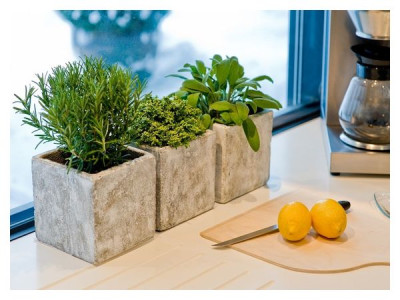On cold winter evenings you really want to warm up with a cup of hot tea that smells of summer and herbs. And this desire is quite possible! By planting aromatic and healthy lemon balm in a pot on the windowsill, you will provide yourself with herbal tea and other drinks all year round. We will tell you about the best varieties of lemon balm for home growing, as well as the intricacies of planting and caring for the aromatic plant.

You can increasingly find lemon balm on the windowsills of city apartments. It’s very convenient to always have fresh spices and medicinal plants on hand. In this article, we want to tell you how to grow lemon balm at home.
The pleasant citrus aroma of lemon balm has won everyone's love. It is customary to brew the leaves of the medicinal plant into tea, make various infusions from them, and decorate dishes with them. People call lemon balm lemon balm, lemon grass, and even ladies' happiness.
You can easily grow lemon balm on a windowsill in winter. The fragrant bush will create a peaceful atmosphere and fill the room with notes of citrus.
Melissa varieties for growing on a windowsill

The medicinal perennial has been cultivated by gardeners for a long time. Unlike growing in open ground, homemade lemon balm is not as fragrant.
However, breeders have developed the best varieties for home use:
- "Lemon scent". Grows in small bushes. The variety grows well both at home and in the country.
- "Mahito". Mainly used in cooking. The main direction is desserts and cocktails.
- "Pure gold". During flowering, the plant changes color from white to blue. One of the most unpretentious varieties. The bushes grow fluffy. The variety is rare.
- "Variegated". Decorative type of grass. A characteristic feature is the golden color along the edges of the leaves.
- "Lemon tea". Has a pronounced lemon scent. An unpretentious plant to care for.
- "Pearl". Bushes 65-70 centimeters high. The leaves are dark green with jagged edges. After 60 days you can harvest.
- "Freshness". Ripening time is 2 months from the start of planting. The leaves have a fresh lemon aroma and a bitter taste.
All types of lemon balm have similar beneficial properties. Differences can only be in the shape of the bush, in the volume of green mass and in the timing of ripening.
What you need to grow lemon balm at home on the windowsill
Lemon grass is a perennial plant that will delight you with its blooming appearance and aroma for at least a couple of years.
In order for the bushes to sprout in time for winter, the perennial can be planted in late summer or early autumn.
You can choose the necessary equipment for planting and growing lemon balm at home at a gardening store, or organize it yourself.
To plant lemon balm you will need:
- Any container for indoor plants and support;
- Nutrient soil;
- Drainage;
- Melissa seeds or branches with roots;
- A well-lit place in the room.
The average height of the bushes on the windowsill is 25-30 centimeters. In order for the plant to gain green mass, the top is periodically trimmed.
Choosing the optimal place in the house for lemon balm

When choosing a suitable place at home, it is important to know that lemon balm prefers long daylight hours and good lighting.
Therefore, a place on the windowsill with sunny sides is ideal. However, prolonged exposure to direct sunlight has a detrimental effect on green leaves - they can turn yellow.
It is not recommended to place lemon balm in a pot at home in places where the sun's rays do not reach. The plant will not die, but it will not grow fully either.
Selection and preparation of containers for lemon balm
Indoor lemon balm is developing rapidly, so for cultivation choose flower pots and trays 30-50 centimeters deep, but not wide. The container must be stable and have holes at the bottom.
The initial planting is carried out in a small pot so that the root system is well rooted.
A year later, when the first transplant is required, a larger container is chosen. There are no strict recommendations here; you can choose any container for lemon balm.
However, natural materials allow air to pass through to the root system. Plastic containers disrupt the process of thermoregulation.
Choosing soil for indoor lemon balm

Like any indoor plant, lemon balm requires fertile soil.
- Since the seeds have low germination rates, the soil should be light and have good air permeability.
- Use purchased universal soil as a basis, or mix it in equal parts with humus.
- Drainage made of expanded clay or small pebbles is evenly distributed at the bottom of the pot.
Lemon grass is not demanding on the quality of the soil, but in fertile soil the plant will grow faster and gain green mass. You should avoid soil with high acidity, otherwise you should not expect normal growth of lemon balm.
Creating the necessary conditions: temperature, air humidity and lighting

Favorable home conditions reduce plant care.
As in open ground, lemon balm prefers a warm climate and good lighting. Therefore, they try to bring the houses as close as possible to natural conditions.
Lack of light affects the general condition of lemon grass: the leaves turn yellow and contain less essential oils, and the bush stops growing.
- In summer, containers with plants are placed on the balcony, avoiding direct sunlight.
- In winter, additional lighting is provided. The lamps are installed above the seedlings no lower than 55-60 centimeters. The duration of artificial lighting is 5-6 hours.
Melissa leaves are sprayed with a spray bottle 2 times a week if the room is too hot.
The optimal room temperature for lemon balm varies from +16°C to +25°C. During the first shoots, it is necessary to maintain a temperature of +18-21°C.
Recommended air humidity for lemon balm is 50-65%. It is not recommended to place pots next to radiators or in drafts.
Growing lemon balm from seeds

Growing lemon balm from seeds at home is the most effective way, although the most labor-intensive.
Indeed, for better germination of seeds, they are first prepared for sowing.
Preparing seeds for sowing step by step:
- Soak the seeds in a weak solution of potassium permanganate for 3-5 hours. The procedure disinfects the seed material;
- Place the seeds in damp gauze for a day or two. You can do without this step, but swelling of the shell increases the chances of germination;
- Distribution of nutrient soil into pre-prepared containers;
- Planting seeds in the ground to a depth of 1.5 centimeters at a distance of 4-6 centimeters;
- Covering future seedlings with film. Polyethylene creates a greenhouse effect.
- It usually takes up to 25 days before the first shoots appear.
- With the appearance of the first shoots, the film is removed. The container with seedlings can be placed on the windowsill.
Growing lemon balm by dividing the bush
The good thing about the method of dividing the bush is that you can get fresh lemon balm leaves in the coming winter.
Melissa usually starts sprouting in May or August. During this period, the bush is divided into shoots and planted in pots.
The method is suitable for those who have fresh lemon balm in their garden in the summer.
Reproduction of lemon balm by layering
The plant is propagated by layering, usually in open ground. At home, this will require a wide container.
The process is as simple as possible: as soon as the lemon balm has bloomed, its shoots are fixed in the soil, carefully bending them down. The length of each shoot must be at least 15 centimeters.
As soon as the shoot takes root, it is separated from the parent bush.
Propagation of lemon balm by cuttings

To propagate lemon grass from cuttings, you need to purchase a fresh stalk of lemon balm.
Then the top is cut off and placed in a vessel with water. The first roots appear on the stems after 10 - 14 days, after which they are transplanted to a permanent place.
It is better not to buy frail and limp stems - it will be of little use.
Caring for lemon balm at home: watering and fertilizing
An unpretentious perennial herbaceous plant can withstand the scorching rays of the sun and long stays in the shade. Despite the unpretentiousness of the grass, it needs to be looked after regularly.
Homemade lemon balm loves moisture, but in moderation. A dry top layer of soil in a pot will indicate that it is time to water the fragrant plant.
Watering rules:
- Abundant watering in the hot season;
- Regular irrigation of leaves with a spray bottle;
- In winter, watering is reduced by half;
- Drying out of the earthen coma is unacceptable;
- Excessive waterlogging of the soil will lead to rotting of the root system.
The water should not be cold and stand for at least a day.
Tea leaves and eggshells are good substitutes for store-bought fertilizers for lemon balm.
The plant is fed with both dry and liquid fertilizers. About once every 2 weeks is enough for good perennial growth.
Use ready-made dry organic and mineral fertilizers. Liquid fertilizers should be diluted with water, following the instructions.
Diseases and pests of lemon balm

Lemon balm or lemon balm is practically not susceptible to diseases and pest attacks.
However, illiterate indoor care leads to irreversible consequences. Limp, dry and falling leaves indicate an excess of moisture.
A soapy household solution destroys lemon balm pests at home.
Lemon grass is disliked by most pests due to its specific smell. Among those wishing to feast on the fragrant leaves are: thrips, whitefly, spider mites and scale insects.
But unlike growing outdoors, the chances of pests appearing in the house are minimal.
Mistakes when growing lemon balm at home on a windowsill
Often seedlings or rooted shoots die. It seems that the owner is taking care of it, creating optimal conditions, but the plant does not respond to excessive care.
Why does lemon balm die?
- The plant is located in a draft;
- The grass feels a lack of sunlight;
- Contact with direct sunlight burns the leaves;
- Excess moisture leads to rotting of the root system;
- The soil is drying up.
Even such an unpretentious plant as lemon balm will not withstand extreme conditions. It is enough to follow the golden mean in care to get a good harvest.
Harvesting and storing lemon balm

- It is possible to cut off the fragrant branches of lemon balm as soon as their height reaches 10 centimeters.
- At the same time, they are carefully trimmed and laid out on a baking sheet in one layer and dried on the windowsill.
- During drying, lemon balm is turned over to prevent mold.
- Store the herb in cotton or linen bags to preserve the aroma and beneficial properties.
Melissa is used fresh to prepare refreshing cocktails, desserts and main courses.
Due to the unpretentiousness of medicinal lemon balm, it is not difficult to grow it on a windowsill or loggia. Good lighting and timely watering are the key to rapid growth and a gain of lush green mass. The first harvest is obtained a couple of months after planting, which is used for culinary or medicinal purposes.









Write a comment